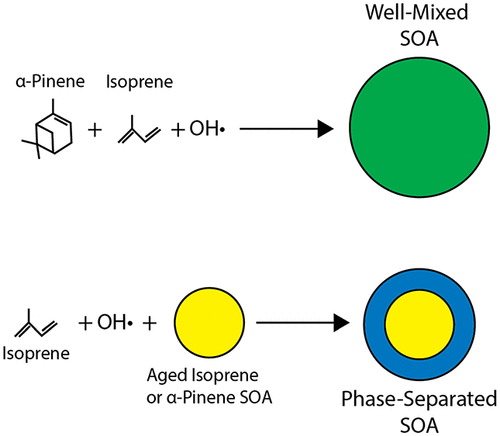当前位置:
X-MOL 学术
›
ACS Earth Space Chem.
›
论文详情
Our official English website, www.x-mol.net, welcomes your
feedback! (Note: you will need to create a separate account there.)
Photochemical Aging Alters Secondary Organic Aerosol Partitioning Behavior
ACS Earth and Space Chemistry ( IF 2.9 ) Pub Date : 2019-11-08 , DOI: 10.1021/acsearthspacechem.9b00248 John E. Shilling 1 , Maria A. Zawadowicz 1 , Jiumeng Liu 1 , Rahul A. Zaveri 1 , Alla Zelenyuk 1
ACS Earth and Space Chemistry ( IF 2.9 ) Pub Date : 2019-11-08 , DOI: 10.1021/acsearthspacechem.9b00248 John E. Shilling 1 , Maria A. Zawadowicz 1 , Jiumeng Liu 1 , Rahul A. Zaveri 1 , Alla Zelenyuk 1
Affiliation

|
Organic aerosol is the largest fraction of the atmospheric nonrefractory aerosol mass and has a significant impact on climate, visibility, and human health. A significant portion of organic aerosol is secondary organic aerosol (SOA), which forms when volatile organic compounds (VOCs) are oxidized and the reaction products partition to the particle phase. SOA formation and aging have been described using semivolatile partitioning theory, and a typical assumption invoked is that gas-particle partitioning rapidly reaches equilibrium. However, several studies have called into question whether traditional equilibrium assumptions are valid, either due to particle-phase diffusion limitations, particle-phase reactions, or liquid/liquid phase separation and immiscibility of organic phases. Here, we investigate the ability of equilibrium partitioning to describe laboratory SOA formation experiments using SOA mass and yield as the evaluation metric. We conduct two types of experiments: (1) co-condensation experiments in which isoprene and α-pinene are simultaneously oxidized to form SOA and (2) sequential condensation experiments in which fresh isoprene SOA is formed in the presence of aged, pre-existing isoprene- or α-pinene-derived SOA particles. In the co-condensation experiments, equilibrium partitioning successfully predicted the time-dependent SOA concentrations, suggesting that the SOA from both precursors rapidly formed a well-mixed phase. However, in the sequential condensation experiments, equilibrium partitioning assumptions significantly overpredicted the observed SOA yield, indicating that freshly formed isoprene SOA did not rapidly partition into either the aged α-pinene or aged isoprene SOA particles to form a well-mixed phase over the 4 h experimental time scale, even at relative humidity as high as 85%. This study shows that an equilibrium partitioning assumption is accurate for freshly formed SOA but that it breaks down after SOA has been photochemically aged for modest amounts of time (15–18 h). These results have important implications for modeling SOA formation and may help to resolve some seemingly divergent conclusions regarding diffusion limitations that exist in the literature.
中文翻译:

光化学老化改变了次级有机气溶胶的分配行为
有机气溶胶是大气非耐火气溶胶中的最大部分,对气候,能见度和人类健康具有重大影响。有机气溶胶的很大一部分是二次有机气溶胶(SOA),当挥发性有机化合物(VOC)被氧化并且反应产物分配到颗粒相时形成。已经使用半挥发物分配理论描述了SOA的形成和老化,并且一个典型的假设是气体颗粒的分配迅速达到平衡。然而,由于颗粒相扩散限制,颗粒相反应,或液相/液相分离和有机相的不混溶性,一些研究质疑传统的平衡假设是否有效。这里,我们研究了使用SOA的质量和产量作为评估指标来描述实验室SOA形成实验的均衡分配能力。我们进行两种类型的实验:(1)共缩合实验,其中异戊二烯和α-pine烯同时被氧化形成SOA;(2)顺序缩合实验,其中在老化的,预先存在的存在下形成新鲜的异戊二烯SOA异戊二烯或α-pine烯衍生的SOA颗粒。在共冷凝实验中,平衡分配成功地预测了随时间变化的SOA浓度,这表明来自两种前体的SOA迅速形成了充分混合的相。但是,在顺序冷凝实验中,平衡分配假设大大高估了观察到的SOA产量,这表明,即使在相对湿度高达85%的情况下,新形成的异戊二烯SOA也不会在4小时的实验时间内迅速分配到老化的α-pine烯或老化的异戊二烯SOA颗粒中,形成均匀混合的相。这项研究表明,平衡分配假设对于刚形成的SOA来说是准确的,但是在SOA经过光化学老化适度的时间(15–18小时)后就会分解。这些结果对建模SOA形成具有重要意义,并且可能有助于解决有关文献中存在的扩散限制的一些看似分歧的结论。这项研究表明,平衡分配假设对于刚形成的SOA来说是准确的,但是在SOA经过光化学老化适度的时间(15–18小时)后就会分解。这些结果对建模SOA形成具有重要意义,并且可能有助于解决关于文献中存在的扩散限制的一些看似分歧的结论。这项研究表明,平衡分配假设对于刚形成的SOA来说是准确的,但是在SOA经过光化学老化适度的时间(15–18小时)后就会分解。这些结果对建模SOA形成具有重要意义,并且可能有助于解决有关文献中存在的扩散限制的一些看似分歧的结论。
更新日期:2019-11-11
中文翻译:

光化学老化改变了次级有机气溶胶的分配行为
有机气溶胶是大气非耐火气溶胶中的最大部分,对气候,能见度和人类健康具有重大影响。有机气溶胶的很大一部分是二次有机气溶胶(SOA),当挥发性有机化合物(VOC)被氧化并且反应产物分配到颗粒相时形成。已经使用半挥发物分配理论描述了SOA的形成和老化,并且一个典型的假设是气体颗粒的分配迅速达到平衡。然而,由于颗粒相扩散限制,颗粒相反应,或液相/液相分离和有机相的不混溶性,一些研究质疑传统的平衡假设是否有效。这里,我们研究了使用SOA的质量和产量作为评估指标来描述实验室SOA形成实验的均衡分配能力。我们进行两种类型的实验:(1)共缩合实验,其中异戊二烯和α-pine烯同时被氧化形成SOA;(2)顺序缩合实验,其中在老化的,预先存在的存在下形成新鲜的异戊二烯SOA异戊二烯或α-pine烯衍生的SOA颗粒。在共冷凝实验中,平衡分配成功地预测了随时间变化的SOA浓度,这表明来自两种前体的SOA迅速形成了充分混合的相。但是,在顺序冷凝实验中,平衡分配假设大大高估了观察到的SOA产量,这表明,即使在相对湿度高达85%的情况下,新形成的异戊二烯SOA也不会在4小时的实验时间内迅速分配到老化的α-pine烯或老化的异戊二烯SOA颗粒中,形成均匀混合的相。这项研究表明,平衡分配假设对于刚形成的SOA来说是准确的,但是在SOA经过光化学老化适度的时间(15–18小时)后就会分解。这些结果对建模SOA形成具有重要意义,并且可能有助于解决有关文献中存在的扩散限制的一些看似分歧的结论。这项研究表明,平衡分配假设对于刚形成的SOA来说是准确的,但是在SOA经过光化学老化适度的时间(15–18小时)后就会分解。这些结果对建模SOA形成具有重要意义,并且可能有助于解决关于文献中存在的扩散限制的一些看似分歧的结论。这项研究表明,平衡分配假设对于刚形成的SOA来说是准确的,但是在SOA经过光化学老化适度的时间(15–18小时)后就会分解。这些结果对建模SOA形成具有重要意义,并且可能有助于解决有关文献中存在的扩散限制的一些看似分歧的结论。









































 京公网安备 11010802027423号
京公网安备 11010802027423号